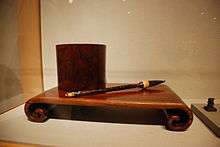Brush pot

A brush pot (Chinese: 笔筒; pinyin: bǐtǒng) is a container for holding the brushes used by scribes for Chinese calligraphy.[1] These are typically carved from bamboo or jade with ornate motifs symbolising concepts such as longevity. Antique examples are now valued highly.[2]
The brushes would be rinsed and stored in the pot with their handle down so that the bundles of hair would keep their shape and point.[3]
Background
In China
Bamboo curved brush pots were likely to be first produced in China, given that the use of bamboo to create articles originated there.[4]
In Korea
After Neo-Confucianism was welcomed as the formal doctrine in Korea at the beginning of the Joseon era, the new intellectually aware and literate yangban replaced aristocrats and Buddhist monks. These yangban consisted of civil servants and military officials.[5] This new elite ruling class spent a significant part of their time in writing calligraphy alongside reading. To satisfy this new demand, production of brush pots started in Korea.[6]
Structure
Made in wood, stone, porcelain and bamboo, brush pots were mostly cylindrical and were often decorated with traditional symbols inscribed on their body. During the Joseon era the royal family exclusively used the dragon motif for their brush pots. Later on the dragon decoration became a common theme.[6] In China, Ivory for its plain but jade-like texture is considered an excellent material for brush pots.[7] Ivory is used in Chinese brush pots because of its resemblance to bamboo.[8]
Value
High quality period Chinese brush pots can fetch high prices. In 2012, a Chinese brush pot made of bamboo was donated to a Bristol-based charity shop. When the shop sold the brush pot to raise funds for St Peter's Hospice, it was sold for £360,000 even though the rim had been mended with glue and the bamboo frame had a substantial crack.[9] Examination of the brush pot discovered that it was made between 1662 and 1722 by Gu Jue, a well known old master of the time.[9]
In the Skinner Asian Arts Auction, an 18th-century 6-inch (150 mm) bamboo Chinese brush pot was sold for $539,500. The pot was inscribed with detailed figures of immortals and animals set in mountainous landscapes.[10]
Uses
Brush pots were used by Chinese and Korean scholars between the 18th and 19th century. Calligraphy brushes were generally kept in the brush pots but intermittently, they were also used to stock paper rolls (rolled-up papers) hence they are sometime also called paper holders.[2][6]
References
- ↑ Oriental Ceramic Society (1984). "Brush pots". Chinese Ivories: From the Shang to the Qing. British Museum. p. 149. ISBN 9780903421225.
- 1 2 "BBC One – Antiques Roadshow – 18th Century Chinese brush pot". BBC. Retrieved 11 November 2015.
- ↑ Pat Kirkham, Susan Weber (2013), History of Design: Decorative Arts and Material Culture, p. 313, ISBN 0300196148
- ↑ 杭间, 郭秋惠 (2006). 中国传统工艺 Cultural China series. 中信出版社. ISBN 9787508509631.
- ↑ "yangban – Korean society". Encyclopedia Britannica. Retrieved 11 November 2015.
- 1 2 3 "British Museum – Porcelain brush pot". British Museum. Retrieved 11 November 2015.
- ↑ "Ivory Brush Pot with Dragons". cultural-china.com. Retrieved 11 November 2015.
- ↑ Stephen Davies (2010). Philosophical Perspectives on Art. Oxford: Oxford University Press. p. 95. ISBN 9780199202430.
- 1 2 "Chinese art collectors scramble to buy battered pot from Bristol charity shop". The Daily Telegraph. 27 May 2012. Retrieved 25 November 2015.
- ↑ "Brush Pot Is Hot At 539,500 At Skinner Asian Arts Auction". antiquesandthearts.com. Retrieved 11 November 2015.
External links
| Wikimedia Commons has media related to Brush pots. |
